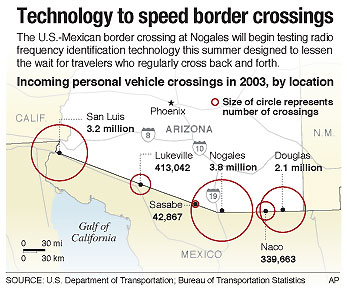Wednesday, January 26, 2005
New plan for border security: Chips on visas track crossings

New plan for border security: Chips on visas track crossings

SHERYL KORNMAN
NOGALES - Foreign shoppers, truckers, tourists and others who regularly cross the border will carry travel documents outfitted with chips that transmit radio signals under a system the U.S. government plans to begin testing this summer.
The idea is to speed crossings without compromising security.
Homeland Security Undersecretary Asa Hutchinson announced the test of the radio frequency identification system here yesterday.
Testing in Nogales will start July 31.
A small device attached to documents will log each visa holder's U.S. entry and exit in a federal database, which will screen for terrorists or wanted criminal suspects.
The radio frequency device will be linked to the person's "biometrics" - the fingerprints and photograph of the visa holder already stored in a federal database.
Testing of the device will be under way by July 31 at five ports of entry, including the two in Nogales, said Hutchinson, who this week presented his resignation to President Bush. The test period is expected to last about six months.
Equipment will be able to receive the device's signal at distances of 15 to 30 feet, Hutchinson said.
The U.S. government will not share the tracking data with other governments and will not track the visa's movements inside the United States, he said, although technology is available to do so.
Freight delivered by rail is tracked in that fashion, he pointed out.
The other U.S. ports taking part in the testing of the device are Alexandria Bay, N.Y., and Pacific Highway and Peace Arch in Washington state.
"Through the use of radio frequency technology, we see the potential to not only improve the security of our country, but also to make the most important infrastructure enhancements into the U.S. land borders in more than 50 years," Hutchinson said in a statement.
The devices could cost as little as 25 cents each. He said types of devices are still being reviewed, and one has not been selected.
If a visa holder's document expires, his information in the database would be dropped and he would have to apply for a new visa and have a new radio frequency device installed in his travel document.
Those with visa waivers also will be required to have a radio frequency device attached to their travel document.
During the testing period in Nogales and elsewhere, Hutchinson said, "We will make adjustments to make sure it works well before a nationwide rollout."
As part of his visit to Nogales, Hutchinson met yesterday with those he called stakeholders in the success of the program.
He met with the mayors of Nogales, Ariz., and Nogales, Son., consular officials and business groups from the area.
When people enter the United States, their visas will be checked by a reader. When they leave the United States, a device at the point of exit will automatically read the visa chip.
The program nationally will first target multientry visa holders.
The Department of Homeland Security's privacy officer will oversee the maintenance of privacy rights of visa holders, Hutchinson said.
Hutchinson did not mention the words terrorist or terrorism yesterday. But he reminded those at a media briefing at the Nogales port of the border protection effort called US-VISIT introduced at Nogales on Dec. 6.
The U.S. Visitor and Immigrant Status Indicator Technology program is an effort to control the international border and spot terrorist traffic.
Under the program, workers at the border take digital, inkless fingerprint scans and digital photographs of each visa holder to determine if the person applying for entry to the United States is the same person to whom State Department officials issued a visa.
The biometric and biographic data are checked against terrorist watch lists and the FBI criminal database.
Hutchinson said his last day on the job as undersecretary will be March 1.